Road-racing and the formation of motor clubs and associations assisted the rapid development of the motor car from 1900 onwards. During the first few years of the twentieth century the foundations of the modern motor industry were laid
STORY OF THE MOTOR CAR - 3
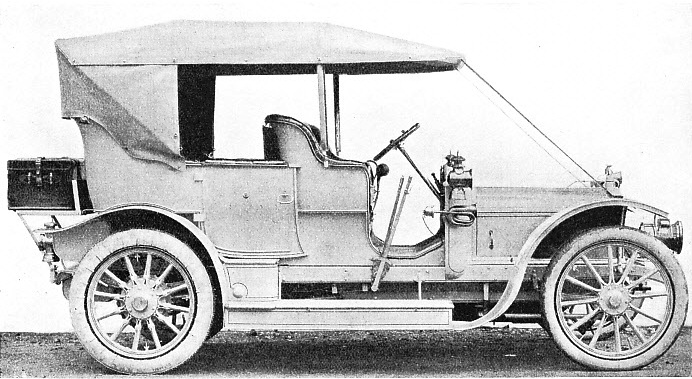
THE FIRST AUSTIN CAR, a 25-30 horse-power tourer, built in the original factory at Longbridge, Birmingham. This car, which appeared early in 1906, was of advanced design for the period and was popular from the first. It had a hood but no windscreen. The Longbridge factory in 1906 employed 270 workers and was able to produce some 120 cars a year.
THE motor car had been, firmly established as a recognized form of transport by the beginning of the twentieth century. The next decade saw some of the most remarkable advances in the production of motor ears, developments which helped to lay the foundations of an industry that now ranks as one of the most important in the world.
In those early days several new factors helped to further the cause of motoring. In 1903 was passed an Act of Parliament which removed many speed restrictions that had been left untouched by the Act of 1896. Road improvements, racing and the formation of motor clubs and associations were other contributory causes that assisted the development of the motor car. Among these bodies were the Motor Union, founded in 1901, and the Automobile Club of Great Britain and Ireland, founded in 1897. The A.C.G.B.I. received the patronage of King Edward VII in 1903 and became the Royal Automobile Club; it is now known all over the world as the R.A.C. The Automobile Association was founded by Colonel W. J. Bosworth in 1905.
The early months of 1900 saw a continuance of the great road races that had marked 1899 as a year of outstanding achievement in motoring history, with average speeds approaching forty miles an hour. Even those records were soon broken, for on February 25, 1900, the Chevalier Rene de Knyff won the great French race, the Circuit du Sud-Ouest, on a 16 horse-power Panhard at an average speed of 43.7 miles an hour. This was remarkably good going, because in those early days almost every component of the motor car could be relied on to make its contribution to a hundred and one causes of breakdown. It was, however, from such failures that motor manufacturers were able to improve design and avoid further trouble. The trials also stimulated public interest, no small consideration at a time when prejudice against the “horseless carriage” was rampant. The newly-created motor industry was fully alive to the business benefits that accrued from the winning of a big race and rivalry between the different firms was extraordinarily keen.
The importance of motor racing is further emphasized by the supremacy, at that time, of cars manufactured on the Continent, where nearly all the important events were held. In France such famous makes as Panhard-Levassor, de Dion, Renault, Delaunay-Belleville, Peugeot and De Dietrich were prominent. In Germany the Mercedes and Benz firms — then separate concerns — made their contribution to the advance of motoring. The early Mercedes was considered by many to be one of the best cars of its time, and among the cars used by King Edward VII were several of this make.
One of the famous Mercedes touring models was the 18-28 horse-power car, and a larger type with a rating of 45-52 horse-power also made a name for itself, Italian cars were represented by Fiat, Itala and Isotta-Fraschini, and Belgian cars by Minerva and F.N. On the other side of the Atlantic, at this time, the motor industry was progressing along somewhat different lines. In the United States, the steam car was being developed side by side with the petrol vehicle. Among the various makes of steam car was the White, the boiler of which was fired by an ingenious automatic system.
The supremacy of Continental cars was soon to be challenged by Great Britain. In 1902 the British Napier car, driven by Selwyn F. Edge, won the famous Gordon-Bennett race, which was run over a course of 386 miles, from Paris to Innsbruck. The 40 horse-power Napier covered the distance at an average speed of over 36 miles an hour.
Apart from their racing cars, however, Napiers were famous for other types of car. In 1902 there was a 12 horsepower Napier on the market, and a year later a 16 horse-power model was introduced. In 1903, however, the year of the first motor exhibition at the Crystal Palace, London, Continental cars earned more honours. The Hon. C. S. Rolls, driving an 80 horse-power Mors, covered the flying kilometre at 82.8 miles an hour. In the same year a 70 horse-power Mors, driven by Gabriel, won the Paris-Madrid race at an average speed of 65.3 miles an hour.
In 1901 the second motor show saw the first announcement of a British six-cylinder car. This was a 30 horse-power Napier, which incorporated several advanced features — a six-cylinder engine with three pairs of cylinders, each pair being cast together; single coil ignition; screw-down lubricators; internal expanding brakes; a metal-to-metal clutch; and a chassis far in advance of the general state of design of the period. The engine speed was 900 revolutions a minute. The introduction of this car created a sensation in motoring circles. For many years the British Napier rivalled the German Mercedes in public esteem. On road and on track, Napier was a name that was scarcely ever out of the public eye.
Gold Medal Winner
Many cars that are now famous throughout the motoring world made their first appearance between 1900 and 1906. The Wolseley firm had begun in 1895 to make light three-wheeled cars with two seats placed back to back. These vehicles were designed by Mr. Herbert Austin (now Lord Austin). The engine used was a twin-cylinder air-cooled model of only 2 horse-power. The first four-wheeled Wolseley car appeared in 1900 and gained a gold medal in the A.C.G.B.I. Thousand Miles Trial, held in April and May of that year.
The Wolseley 5 horse-power car, also designed by Mr. Austin, was typical of the earlier light vehicles. The car had a wheelbase of 6 ft. 4 in. and the engine was placed horizontally at the front end of the chassis with the head of the single water-cooled cylinder pointing forward. The engine was fitted with a heavy flywheel at either end, and the right-hand wheel, looking forward, formed part of the clutch. From the clutch shaft a chain was taken to the gearbox. This was placed transversely across the chassis frames, and from its ends projected sprocket shafts that drove the rear wheels by chains on either side. The rear axle was not fitted with a differential, that component being incorporated in the same casing as the change-speed gears.
The Wolseley 10 horse-power car, as developed in 1903, was similar to the 5 horse-power car in general design and in the arrangement of the engine, gearbox and chain drive. The engine, however, had two cylinders instead of one and a secondary clutch was provided. This auxiliary clutch was used to overcome the inertia effects due to the weight of the rotating components when the main clutch was out. The 20 horse-power Wolseley car of 1904, with tonneau body, resembled the 10 horse-power model in general appearance, but the engine had four cylinders and double silent chains were used for the drive to the gearbox.
The Wolseley arrangement of engine and power transmission was peculiar to that make of car, and most cars built between 1900 and 1903 resembled the car of to-day in their layout. The cylinder, or bank of cylinders, was placed vertically at the front with the crankshaft parallel with the line of the frames. The flywheel and clutch were immediately behind the engine. Then came the gearbox and finally a longitudinal shaft, with a universal joint at either end, driving the rear wheels through the differential gear.
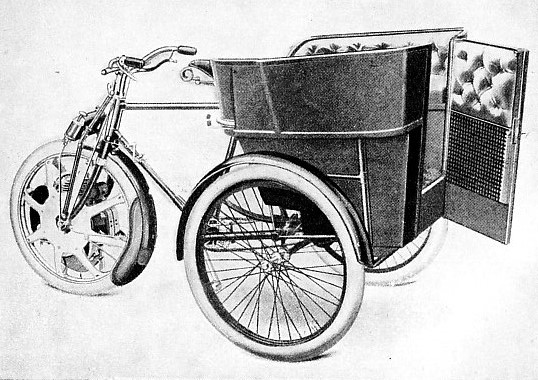
SINGER GOVERNESS CAR OF 1903. This neatly designed vehicle had a 2½ horse-power engine inside
the front wheel, which it drove by gears. The chassis was that of a modified motor tricycle, with a small governess car body mounted between the two rear wheels. The total seating accommodation was five.
In some makes this arrangement was varied by the use of a chain drive from the gearbox, in place of the shaft. Among cars of this type was the French 6½ horse-power Darracq of 1900-1, with a single cylinder water-cooled engine running at 1,400 revolutions a minute. The inlet valve was automatic and the exhaust valve was operated by a gear-driven cam. Speed was controlled by advancing or retarding the spark and by adjusting the amount of lift of the inlet valve. Both operations were carried out by hand levers on the steering column.
The cylinder cooling system consisted of a gilled tube radiator in front of the engine, over the top of which, and beneath the bonnet, was placed a large water tank. Water was circulated from this tank through the cylinder jacket and the radiator by a gear-driven centrifugal pump. The Darracq car of this period was also built in larger sizes, notably a 9 horse-power type. Somewhat similar cars were built by the Renault and de Dion firms; these cars were mostly of 8 or 9 horse-power.
In the United States of America one of the greatest figures in all motoring history — Henry Ford — was born on a farm at Dearborn, Michigan, on July 30, 1863. At the age of twelve, when driving one day into Detroit with his father, Henry Ford saw his first mechanical road vehicle — a steam traction engine. The engine made the customary halt to allow the Fords’ horses to pass in safety. In a moment young Henry Ford had leapt from the farm wagon and was talking to the engine driver. That steam tractor aroused the boy’s enthusiasm for the mechanical form of road transport in which he was destined to play so important a part.
Henry Ford tried to make models of the engine, and finally succeeded in building one that worked well. Any kind of mechanical work came naturally to Henry Ford, from watchmaking to the heavy tasks in the Drydock Engine Works, where he was apprenticed after having left school at the age of seventeen. Later Ford worked on the road engines of the Westinghouse Company of Schenectady, and he built an experimental steam car.
Henry Ford’s Racing Cars
Henry Ford soon became convinced that steam was not ideal for road vehicle propulsion, and his attention was drawn to the Otto gas engine through the medium of a British technical journal, The World of Science.
In 1887 Ford made a small model of an Otto gas engine with a bore of only 1 in. and a stroke of 3 in. This engine worked quite well on gas obtained from petrol — still known as gasoline to all Americans.
After many experiments Ford completed his first motor car in 1892. This car had two cylinders with 2½ in. bore and 6 in. stroke, placed side by side over the rear axle. The engine developed about 4 horse-power. Power was transmitted to a countershaft by a belt, and thence by chain to the rear wheels. The car seated two people and was carried on 28-in. bicycle wheels with rubber tyres. These experiments of Ford’s were carried out independently of those undertaken by Benz and others in Europe. In 1899 Ford left his employment with the Detroit Edison Company, and went into the motor business as chief engineer of the newly formed Detroit Automobile Company. For three years this concern built cars on the lines of Ford’s original machine, but in March 1902 Henry Ford resigned and the firm later became the Cadillac Motor Company. Ford rented a small brick shed at 81, Park Place, Detroit, and began the development of a four-cylinder engine for motor-car use.
In 1903 Ford produced two big racing cars. He was assisted in their building by T. Cooper. The four-cylinder engines of these cars were of 80 horsepower. The builders named one car “The Arrow”, and the other “999”. In one of his intensely interesting accounts, Henry Ford admits that neither he nor Cooper wanted the responsibility of running the cars in a race, although they had both driven the machines “flat out”. They enlisted the services of a professional bicycle rider, Barney Oldfield, who had never driven a car, but was sufficiently fond of speed to relish the attempt.
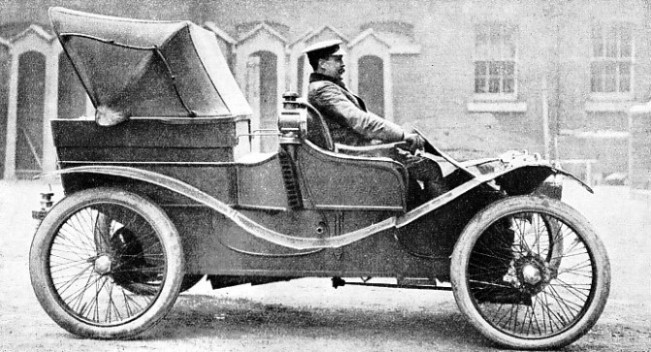
THE MILITARY LANCHESTER, first seen at the Motor Exhibition of 1906. The passengers sat facing the rear of the vehicle and were protected from the weather by a collapsible hood. Tiller steering was used, and an unconventional appearance was given to the car by the absence of a radiator in front of the driver. The engine was mounted below the driving seat.
Barney Oldfield, steering with a two-handed tiller, let “999” go all out (on curves as well) over a three-miles course and beat the man in second place by half a mile. Henry Ford had demonstrated that he could build a fast car, and one week later he formed the Ford Motor Company, of which he was vice-president, designer, master-mechanic, superintendent and general manager.
The first Ford car, Model A, was of 8 horse-power, with a 6-feet wheelbase and a fuel capacity of five gallons. The engine was of the two-cylinder opposed type driving through chains. The company made and sold 1,708 of these cars in the first year of its existence, and in the second year an improved form of Model A (known as Model C) was produced, as well as the Model B touring car, with four cylinders, and the Model F tourer, with two-cylinder opposed engine. Henry Ford designed and produced eight different models before concentrating on the famous Model T in 1909. By that year the floor space at the Ford factory had been increased from a quarter of an acre to two and a half acres, and the number of employees from 311 to 1,908.
During 1908-9 the Ford Motor Company sold 10,607 cars, and by the end of 1914 the figure for its annual production had passed the quarter-million mark. The original Ford Model T was designed on the simplest possible lines. The four-cylinder engine had cylinders of 3¾ in. bore and 4 in. Stroke. The clutch was of the multiple disk type, and the magneto was built into the engine. A special feature of the Ford Model T was the standardization of the chassis, irrespective of the style of the bodywork.
Among the car manufacturers established in Great Britain before 1900 the Daimler Company may justly be regarded as one of the most important. During the summer of 1904 Daimler cars gained important awards at some of the most keenly contested hill climbing and reliability trials held in Great Britain. The Daimler engine, even of those early days, was of outstanding merit. Popular sizes were 12, 18 and 28 horse-power, all with four water-cooled cylinders. The valves were arranged on one side of the cylinders and were operated through tappets by a single camshaft along the upper part of the crankcase.
Dual Ignition
Another famous name which came into prominence during this period was that of the Humber Company, which had been formed in 1887 for manufacturing bicycles. The first Humber car was of 3½ horse-power, and was known as the Phaeton. One of the most interesting of the Humber cars of this early period was the 12 horse-power model which appeared in 1902. In this car the whole of the framework was built of steel tubing brazed into special sockets. The side trussing, with vertical tubes near the centre connected by sloping members to the frame ends, was similar to that now used on steel railway coaches. Within the framework were transverse and longitudinal tubes that carried the gearbox and engine. The exhaust valves were operated by a camshaft and tappets, as in the Daimler engine, but the inlet valves were automatic. The exhaust valves were subject to a governing device to control speed when the clutch was disengaged, a common feature on most early petrol engines.
An interesting feature of the 12 horsepower Humber engine up to 1903 was the provision of a dual ignition system; hot tubes were arranged horizontally in the cylinder heads, on the opposite side of the valves, and the sparking plugs were placed at the top. Even when car designers had decided to put their trust wholly in electric ignition some cars were fitted with a two-way switch so that the driver could change from magneto to coil and battery operation if necessary.
The year 1902 saw also the formation of the famous firm of Clement-Talbot. The first Talbot car was produced in London by a French engineer, M. Adolphe Clement, and by the Earl of Shrewsbury and Talbot. The Talbot soon established a reputation, and a Talbot won the Melbourne-Sydney reliability contest held in Australia in 1905.
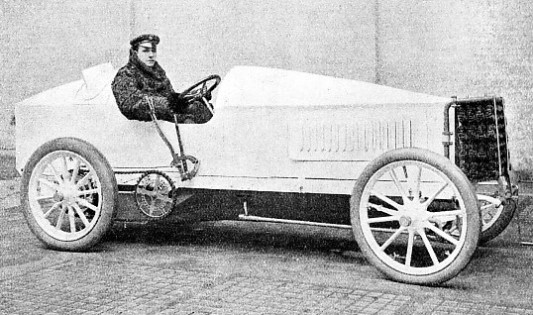
DE DIETRICH RACING CAR of 1903, with Lieut.-Col. Charles Jarrott at the wheel. This car was one of a team of three entered for the Paris-Madrid Race of 1903. The race was marred by several serious crashes, and proved to be the last of the series. It was won by Gabriel, driving a 70 horse-power Mors, at an average speed of 65.3 miles an hour-
Another British firm founded in the pioneer days of motoring was the Standard Motor Company, Ltd., of Coventry, established by Reginald W. Maudslay in 1903. The first Standard car, known as the “Bull Dog”, exhibited some remarkable features. The single-cylinder 9 horse-power engine had the unusual dimensions of 5 in. Bore with a stroke of only 3 in. and it was housed under the front seat. There was no bonnet on the car, but the body work was exceptionally good, although rather elaborate. The car was a four-seater and was ahead of its time in having side-entrance doors to front and rear seats in place of the more usual tonneau with the entrance at the back.
In the original small workshop in Coventry, the first year’s work produced six Standard cars. There were six employees, and their weekly wages, totalling £11, were entered in a penny exercise book carried in the pocket of Mr. Maudslay.
In 1904 the number of Standards produced was nine, and these had twin-cylinder engines under a bonnet, the radiator being at the front of the car. The following year the Standard six-cylinder car was evolved, a model that was destined to bring greatly increased prosperity to the company.
Another of the pioneers of motor manufacture was the Singer Company, and in this instance also the business was founded on the bicycle. George Singer began to make bicycles in Coventry in 1876, and the Singer cycle soon became widely known. In 1900 Singer introduced a 2 horse-power motor cycle, the engine of which was fitted in the back wheel, which it drove by gearing. About the same time there appeared a Singer motor tricycle, with the engine enclosed in the front wheel; a larger engine, of 2½ horse-power, was introduced later.
The Singer motor tricycle was later developed into a kind of cyclecar, with passenger accommodation arranged over the two rear wheels. Among vehicles of this type were the “Tri-Voiturette”, with a seat facing or back to the direction of travel, and the “Governess Car”, which had a coach-built body designed on the lines of the horse-drawn vehicle of that name. These Singer cycles and cyclecars were exceptionally neat in appearance. The 1903 Singer catalogue showed a modification in the form of a 3 horse-power motor bicycle, in which the engine was at the side of, and not inside, the back wheel. Chain drive was used.
In 1904 the first Singer motor car made its appearance. This was a two-seater with a two-cylinder engine. This car somewhat resembled a modern car as far as chassis and bodywork were concerned, but the seats were surmounted by an immensely tall straight-backed hood that projected right over a large two-piece windscreen nearly as far as the radiator.
Another car that was first made in 1904 was the Rover, and in this instance also the car was the successor to the bicycle. The fortunes of the original Rover Cycle Company were founded as long ago as 1877 by John K. Starley, who produced the first “safety” bicycle. The name of the company was changed to the Rover Company, Ltd., and its first car was a single-cylinder model of 8 horse-power.
Three-Cylinder Rolls-Royce
The year 1904 saw also the beginning of yet another concern famous all over the world for the excellence of its motor cars — the firm of Rolls-Royce. The Hon. Charles Rolls was a keen racing motorist, who early in life had earned a high reputation in motoring circles.
Working in collaboration with Henry Royce, a manufacturer of electrical machinery in Manchester, Charles Rolls produced a series of cars beginning with a 10 horse-power two-cylinder model, a three-cylinder car of 15 horse-power, and a 20 horse-power four-cylinder motor. Messrs. Rolls-Royce later produced a 30-horse power car with six cylinders, the forerunner of a great line of famous motors.
The Vauxhall is another British car that had its origin in the early years of the present century. The first Vauxhall car, fitted with a 5 horse-power single-cylinder engine and tiller steering, was produced at the Vauxhall Iron Works in South London. This model was succeeded by a single-cylinder car of 6 horse-power in 1904 and in the following year a three-cylinder car of 7 horsepower was made. It was in 1905 that the firm moved to Luton (Bedfordshire), where the present works of Vauxhall Motors, Ltd., are situated.
Although two cylinders were generally used for 8 and 10 horse-power cars and four in the more powerful machines, many cars of the 1900-5 period, in addition to the Vauxhall and Rolls-Royce, had three cylinders. An instance of this practice was found in the 1905 Panhard and Levassor landaulette, which was equipped with a three-cylinder engine of 8-11 horse-power. Another car of this period fitted with a three-cylinder engine was the 20 horse-power Maudslay. The three cranks were set at angles of 120 degrees and the inlet valves were automatic. The exhaust valves were operated by an overhead camshaft driven by a vertical shaft and gearing from the main crankshaft. The camshaft somewhat resembled that used on modern diesel engines and a feature of its design was that it could be swung back to provide access to the valves.
Y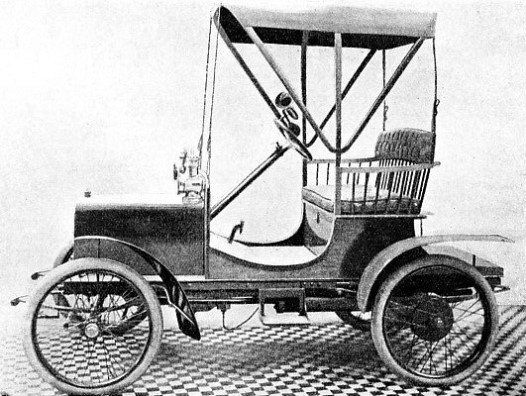 et another car equipped with a three-cylinder engine was the 12 horse-power Brooke. The engine was placed transversely in the frames and drove the central gearbox by chain at one side.
et another car equipped with a three-cylinder engine was the 12 horse-power Brooke. The engine was placed transversely in the frames and drove the central gearbox by chain at one side.
“ALL-WEATHER BODYWORK” on the Calthorpe car of 1906. Bodywork of the period was sketchy; the saloon was unknown and many open cars were not provided with weather protection of any kind. In general layout, however, such cars as the Calthorpe were similar to those of to-day.
You can read more on “Modern Traffic Control”, “Romance of Motor Car Making” and “The Work of Benz and Daimler” on this website.









 et another car equipped with a three-
et another car equipped with a three-